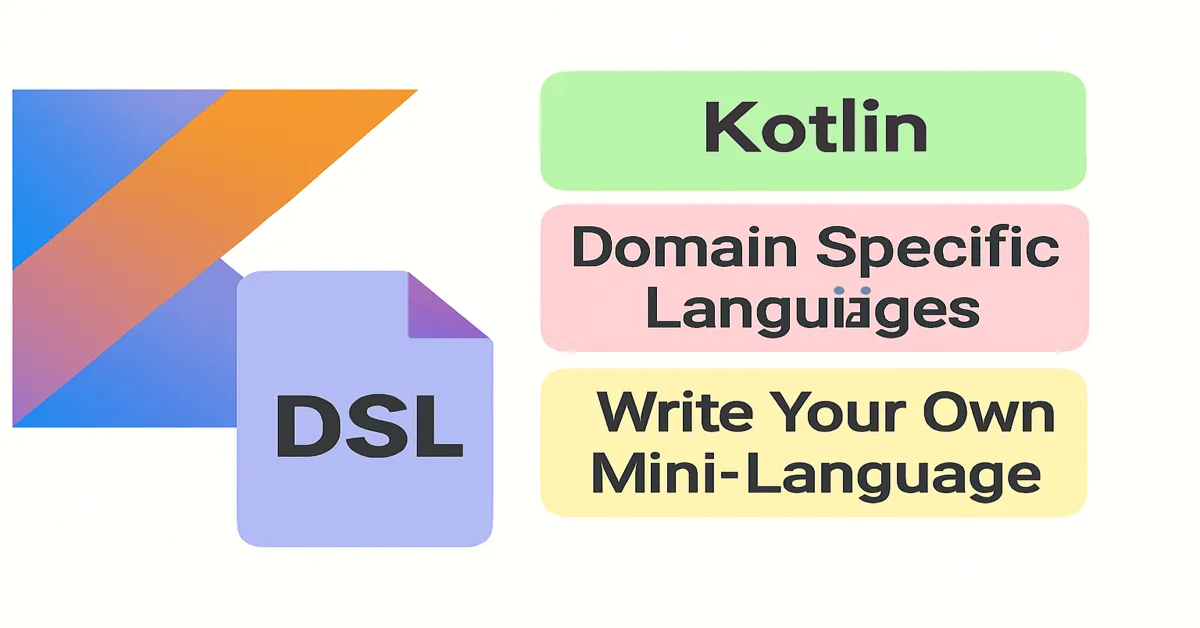In the ever-evolving world of software development, clarity and expressiveness of code are paramount. One of Kotlin’s standout features is its ability to support the creation of Domain Specific Languages (DSLs)—mini-languages tailored to specific problem domains. Kotlin DSLs empower developers to write code that reads almost like natural language, making complex logic easier to understand, maintain, and extend.
In this in-depth exploration, we’ll uncover what Kotlin DSLs are, why they matter, and how you can build your own mini-language to supercharge productivity and readability in your projects.
What is a Domain Specific Language (DSL)?
A Domain Specific Language is a programming or specification language dedicated to a particular problem domain. Unlike general-purpose languages, DSLs provide constructs that directly represent concepts within that domain. This specialization leads to code that’s more expressive and easier for domain experts to understand.
Examples of DSLs
- SQL for database queries
- Regular expressions for pattern matching
- HTML/CSS for web markup and styling
While these DSLs are often external languages, Kotlin’s support enables internal DSLs—written as Kotlin code but crafted to look like custom languages.
Why Kotlin for DSLs?
Kotlin offers a unique blend of language features that make DSL creation remarkably smooth:
- Lambda with receivers: Enables a clean, intuitive builder syntax.
- Extension functions and properties: Add domain-specific behavior to existing types.
- Infix functions: Write expressions that resemble natural language.
- Named and default parameters: Increase expressiveness and reduce boilerplate.
- Operator overloading: Allows DSLs to use symbols familiar to users of the domain.
These features allow Kotlin DSLs to blur the line between code and domain language, increasing accessibility.
Anatomy of a Kotlin DSL: Building Blocks
1. Builders and Lambda Receivers
Kotlin DSLs often use builder patterns combined with lambdas that have receivers to create fluent APIs.
kotlinCopyclass Robot {
var name: String = ""
fun sayHello() = println("Hello, I am $name")
}
fun robot(block: Robot.() -> Unit): Robot {
val robot = Robot()
robot.block()
return robot
}
// Usage:
val r = robot {
name = "KotlinBot"
sayHello()
}
Here, the lambda’s receiver is a Robot instance, letting users write code that feels natural and scoped.
2. Infix Functions
Infix functions allow writing statements that look like natural language.
kotlinCopyinfix fun Int.times(str: String) = str.repeat(this)
println(3 times "Bye ") // Prints: Bye Bye Bye
3. Extension Functions and Properties
These allow DSL authors to enrich existing classes with domain-specific behavior.
kotlinCopyval String.isEmail: Boolean
get() = this.contains("@")
println("test@example.com".isEmail) // true
Real-World Examples of Kotlin DSLs
1. HTML Builders
One of the most popular examples is the Kotlin HTML DSL, which lets you build web pages in Kotlin:
kotlinCopyhtml {
head {
title { "My Page" }
}
body {
h1 { "Welcome" }
p { "This is a Kotlin DSL example." }
}
}
This DSL uses lambdas with receivers to nest tags naturally.
2. Gradle Kotlin DSL
Gradle’s build scripts can be written in Kotlin DSL, offering type-safe and IDE-friendly configurations:
kotlinCopyplugins {
kotlin("jvm") version "1.9.0"
}
dependencies {
implementation("org.jetbrains.kotlin:kotlin-stdlib")
}
IDE support like auto-completion and refactoring is a huge productivity boost.
3. Anko (Deprecated but Educational)
Anko was a Kotlin DSL for Android layouts that allowed declaring UI programmatically instead of XML:
kotlinCopyverticalLayout {
val name = editText()
button("Say Hello") {
setOnClickListener { toast("Hello, ${name.text}!") }
}
}
Though discontinued, Anko inspired many DSL concepts in Kotlin.
Building Your Own Mini-Language: Step-by-Step
Let’s walk through creating a simple DSL for defining a to-do list.
Step 1: Define Data Models
kotlinCopydata class TodoTask(val name: String, val completed: Boolean = false)
class TodoList {
private val tasks = mutableListOf<TodoTask>()
fun task(name: String, completed: Boolean = false) {
tasks += TodoTask(name, completed)
}
fun show() = tasks.forEach { println("[${if (it.completed) "x" else " "}] ${it.name}") }
}
Step 2: Create Builder Function
kotlinCopyfun todoList(block: TodoList.() -> Unit): TodoList {
val todoList = TodoList()
todoList.block()
return todoList
}
Step 3: Use Your DSL
kotlinCopyval myList = todoList {
task("Buy groceries")
task("Walk the dog", completed = true)
}
myList.show()
Output:
cssCopy[ ] Buy groceries
[x] Walk the dog
This mini-language lets you clearly express tasks with minimal ceremony.
Advanced DSL Techniques
1. Scoped Configurations
Make DSLs safe and clear by limiting what’s accessible in different contexts.
kotlinCopyclass EmailConfig {
var host: String = ""
var port: Int = 25
}
fun emailConfig(block: EmailConfig.() -> Unit): EmailConfig {
val config = EmailConfig()
config.block()
return config
}
val config = emailConfig {
host = "smtp.example.com"
port = 587
}
2. Operator Overloading
Improve readability by overloading operators for domain operations.
kotlinCopydata class Point(val x: Int, val y: Int)
operator fun Point.plus(other: Point) = Point(x + other.x, y + other.y)
println(Point(1, 2) + Point(3, 4)) // Prints: Point(x=4, y=6)
3. Inline Classes and Type-Safety
Use inline classes to create domain-specific types with zero runtime overhead.
kotlinCopy@JvmInline
value class Email(val value: String)
fun sendEmail(to: Email) {
println("Sending email to ${to.value}")
}
sendEmail(Email("test@example.com"))
Testing and Maintaining Kotlin DSLs
- Use unit tests to verify DSL behavior
- Ensure descriptive error messages for misuse
- Document expected usage patterns
- Provide IDE support through type-safe builders
Benefits of Kotlin DSLs in Modern Development
- Expressiveness: Write code that reads like human language
- Safety: Type-safe builders reduce runtime errors
- Maintainability: DSLs encapsulate domain logic cleanly
- Productivity: Reduced boilerplate and clearer intent speed development
Challenges and Considerations
- DSLs can introduce learning curves
- Overuse can lead to obscurity if too abstract
- Balance between readability and complexity is essential
The Future of Kotlin DSLs
With Kotlin evolving rapidly, DSLs are becoming more powerful and integrated into frameworks. Expect better tooling, enhanced compiler support, and broader ecosystem adoption in 2025 and beyond.
The line between general-purpose and domain-specific programming continues to blur, making DSL mastery a valuable skill for modern developers.
Conclusion
Kotlin DSLs offer an elegant way to bridge the gap between code and domain knowledge. By crafting mini-languages tailored to specific problems, developers write code that’s not just functional but also beautiful and intuitive.
Whether you’re designing build scripts, configuring servers, or defining business rules, Kotlin DSLs empower you to express intent clearly and concisely. Embracing this approach in your projects can lead to better communication, fewer bugs, and faster development cycles.
In the hands of thoughtful developers, Kotlin DSLs transform programming from a technical task into a creative, expressive art form.
Read:
Kotlin Multiplatform Mobile (KMM): Write Once, Run on Android & iOS
Mastering Jetpack Compose with Kotlin: Build Declarative UIs in 2025
Building RESTful APIs with Kotlin and Ktor: A Beginner-to-Pro Guide
Spring Boot with Kotlin: Boost Your Productivity in Web Development
Kotlin Coroutines in Depth: Asynchronous Programming Made Easy1
FAQs
1. What exactly is a Kotlin DSL and how does it differ from regular Kotlin code?
A Kotlin DSL is a specially designed API written in Kotlin that reads like a custom language tailored to a specific domain. Unlike regular Kotlin, DSLs emphasize expressiveness and readability by using language features like lambdas with receivers and infix functions.
2. What are the main Kotlin language features that enable DSL creation?
Key features include lambda expressions with receivers, extension functions and properties, infix notation, named parameters, operator overloading, and type-safe builders. These make the DSL code expressive and natural to write and read.
3. Can Kotlin DSLs be used for both internal and external domain languages?
Kotlin DSLs are primarily internal DSLs, meaning they are Kotlin code designed to look like a custom language. External DSLs, like SQL, are separate languages. Kotlin DSLs offer the advantage of seamless integration and IDE support.
4. Are Kotlin DSLs only useful for small projects or can they scale to large systems?
Kotlin DSLs can scale to large, complex domains by modularizing the DSL and providing clear abstractions. Many production tools, like Gradle’s Kotlin DSL, prove that well-designed DSLs can handle enterprise-level complexity.
5. How do Kotlin DSLs improve developer productivity?
They reduce boilerplate, improve code readability, and make domain logic easier to express and maintain. This leads to faster development cycles, fewer bugs, and better communication between developers and domain experts.











